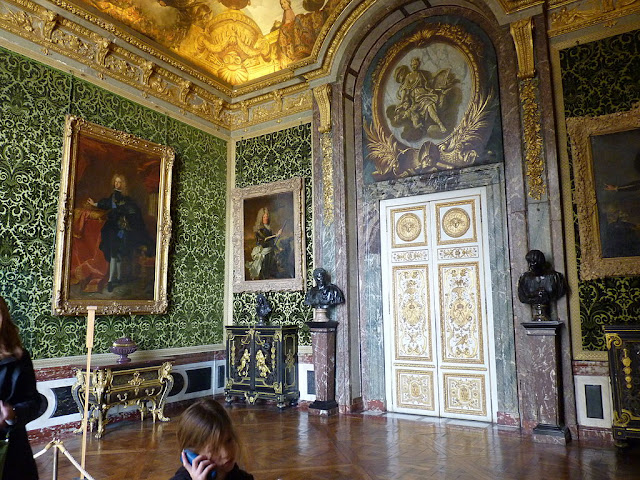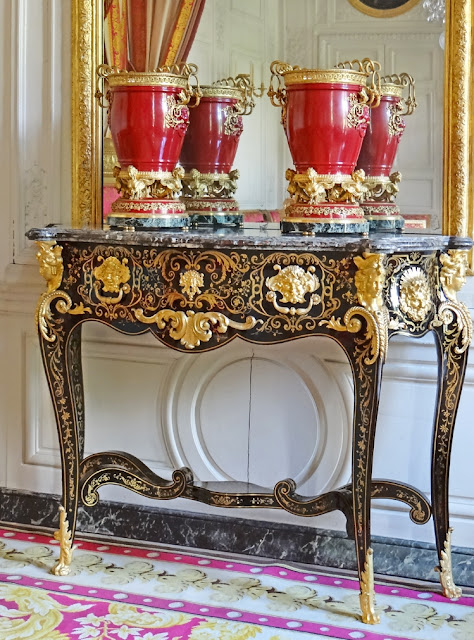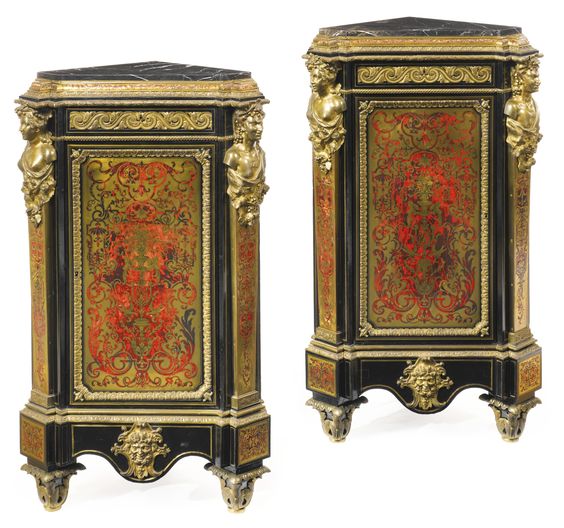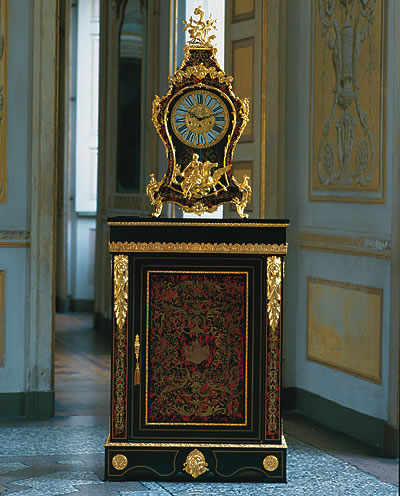Some of the most beautiful and sought after furniture in France from the reign of Louis XIV through the reign of Napoleon was the work of André Charles Boulle. Boulle (1642-1732) was the most famous furniture maker in French history. His mastery of the art of marquetry, also known as inlay, gave him the distinction of "the most skilled craftsman in his profession" and earned him the prestigious appointment to premier ébéniste du roi (principal cabinetmaker to the King) Louis XIV of France.The intricacy and opulence of his work made Boulle highly sought after during his lifetime and afterwards as his style continued with tremendous success in France during the 18th century and under Napoleon III.
Boulle perfected a type of exquisite marquetry involving veneering furniture with tortoiseshell and pewter that is inlaid with flourishes of brass. It is known as Boulle work, a technique that while named after him, he did not invent.
Sadly, most original Boulle furniture has not survived due to the fact that it's beautiful inlay materials were only held in place by glue. Today Boulle pieces are usually only found in private collections and museums. I hope you enjoy the images of this fabulous French furniture.
wikipedia.org
Unfortunately this tiny image is the only picture I could find of the man himself. It is sad that a man responsible for some of the most beautiful furniture in France during the reign of Louis XIV has no significant likeness to be remembered by.
Photography by Ricardo Tulio Gandelman
Pieces of Boulle furniture in Château de Versailles, salon de l'abondance. Furniture had to make a real statement in order to be seen in some of the opulent interiors of the day. To make sure his pieces would stand out in a room Boulle would often opt for a black and gold palette through the use of ebony and gilt bronze.
Photography by Pierre-Yves Beaudouin
Metropolitan Museum of Art
Marquetry is the art of creating extremely detailed pictures and elaborate designs on furniture. This is done through the process of cutting and fitting together very thin pieces of exotic materials such as ivory, horn, shell, metal, and wood and then gluing them on the furniture piece. In the 17th and 18th centuries of France, this advanced form of furniture decoration reached a new artistic level thanks to Boulle.
To fully appreciate of the time and craftsmanship it took to create these pieces, you might want to watch this video.
Photography by Jean-Pierre Dalbéra
This black and gold Boulle console with marble top is in Le Grand Trianon at Versailles.
Photograph by NonOmnisMoriar
A beautiful Boulle piece at Château de Chantilly.
Photograph by O.Taris
This fabulous piece of Boulle furniture, complete with gilded bronze (ormolu) caryatids, holds court at Chateau Vaux-le-Vicomte.
Metropolitan Museum of Art
A Boulle clock that shows the pewter inlay on tortoise shell up close.
Boulle also made his own bronzes. In the guild system, only cabinetmakers could make make cabinets, only bronziers could cast bronze mounts, and gold leaf had to be applied by gilders. A perk of being premier ébéniste freed Boulle from the restrictions of the trade guilds and made it possible for him practice two trades at the same time.
Photography by Jean-Pol Grandmont
This amazing bureau plat is another piece of Boulle furniture from the Chateau Vaux-le-Vicomte collection.
Some of the most spectacular works by the French furniture maker André Charles Boulle are in The Wallace Collection, UK.
J. Paul Getty Museum
This cabinet on stand is attributed to André Charles Boulle. Boulle also perfected the art of wood marquetry and this piece features that kind of marquetry. It is oak veneered with pewter, brass, tortoiseshell, horn, ebony, ivory, and wood marquetry. The drawers are snakewood and the figures are painted and gilded oak.
Photograph by Gordibach
Armoire attributed to Boulle at the musée du Louvre
For contrasting woods, he would also use ebony, rosewood, kingwood, and other dark-toned tropical species.
Boulle's marquetry style swept Europe and was heavily imitated during the 18th and 19th centuries. Here is a Louis XIV ormolu mounted, brass inlaid red tortoiseshell and Boulle marquetry commode attributed to Nicolas Sageot, circa 1700. Even though another cabinet maker would make a piece in the Boulle style it was referred to as "Boulle work".
Upon his retirement the studio was left to his sons who continued to make furniture in his signature style. Boulle style continued with tremendous success in France during the 18th century and under Napoleon III. This secretary abattant is a piece from the reign of Napoléon III.
The most common materials used to create Boulle work are tortoiseshell and brass, which produces that beautiful, mottled red aesthetic as can be seen in this pair of Boulle work corner cabinets (encoignures) from the 19th century.
A Napoleon III gilt bronze mounted ebonized wood and Boulle work marquetry cabinet.
via Pinterest
A French André Charles Boulle style mantel clock.
oldclock.net
An elegant French Boulle marquetry clock featuring gilt bronze, tortoiseshell, brass, and wood.......circa 1870.
oldclock.net
pinterest.co.uk
A tall pair of Boulle style gilt-bronze mounted ebony, engraved brass and tortoiseshell marquetry inlaid pedestals from France, mid-19th century.
anticswiss.com
Boulle work table by Charles Guillaume Diehl. The Boulle style remained popular and inspired numerous cabinetmakers.
via Pinterest
Chairs were also embellished with Boulle work.
A French Boulle tea caddy. Even the smallest pieces are exquisite.
Click here to see the previous post
This blog post was published by Lisa Farmer

































